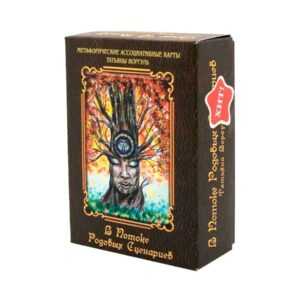Author – Natalia Filimonova, co-author – Evgenia Baksan
The tool provides a unique opportunity to carry out constellation work and explore the topic of gender.
Contents:
2 text decks for metaphorical cards:
– “Members of the family system – Genogram” with degree of relationship (parents, grandparents, great-grandparents, great-grandparents) – 14 cards,
– “Members of the family system” with degree of relationship (stepfather, aunt, husband, wife, unborn child, rescuer, aggressor, etc.) – 20 cards.
– Instructions with ways to work with the tool, an appendix with the “Genogram” diagram, “Speakers” list, “Permission phrases” list, “Messages-Questions” list,
– Pouch.
Additionally, it is recommended to use any portrait, universal and resource deck (not included in the set).
Objectives: explore your family system to solve problems in the present and future; identify negative dynamics (identifications, interweavings, triangulations, etc.) coming from the family system; give place to relatives excluded from the clan system; explore the violation of laws: belonging, hierarchy, balance of give and take; understand the causes of life’s difficulties and relationships; find resources for a further happy life and restoration of the flow of love in the family.
A set of cards can be used to work with any request:
Loneliness, relationships with others, relationships with the opposite sex, money issues, career issues, search for purpose, projects and business, health in general or a specific symptom, lack of energy, self-esteem and other topics.
“The method of Systemic Constellations, already identified as a separate branch of psychology, is still considered phenomenological.
The phenomenological method is an interconnected unity of principles and procedures for the essential study of the data of primary experience – phenomena.
System Constellations are based on several, now widely known, methods that were also previously questioned:
1. Jung’s Theory of the Collective Unconscious.
2. The effect of incompleteness of Bluma Vulfovna Zeigarnik and the resulting from it.< br> 3. Gestalt psychology.
4. Transactional analysis of repetitive scenarios.
5. Family systems theory.
6. Family sculpture by Virginia Satir.
7. Psychodrama by Jacob Moreno.
8. Eriksonian hypnosis.
How does the Morphogenetic (Morphic/Knowing/Informational) Field work in constellations?
Today no one will argue with one of the key laws of physics – the Law of Conservation of Energy, which states:
“Energy cannot arise from nothing and from nowhere, and not go to nowhere. Energy can only move from one form to another.”
This can be compared to the work of an Internet search engine.
For example, all the pictures that we find using a correctly specified query were once saved by someone, and they remain forever on the World Wide Web.
Also, everything that happens to people, their thoughts and actions remain forever in the world’s memory, in what Carl Gustav Jung once called the Collective Unconscious.
As well as the fact that we continue to see the light of long-extinguished stars…
PS Is it really in your head that the stars are no longer there? several thousand years, but its light is there, and many more generations of our descendants will see it?
There are three basic laws in the family system:
Law – 1 “Law of Hierarchy”
It says: “the one who came into the system earlier, more important than those who come later.”
This means that for the family system, parents always rank higher than children, respectively, grandparents rank higher than parents, great-grandparents -nbsp;nbsp ;above grandparents, etc.
Law – 2 “Law of Belonging”
In a nutshell, it can be described as follows: anyone who was born in this family or has greatly influenced the system, positive or negative thus have the right to belong to this family, even if this is not the most worthy person, in the opinion of relatives.
Law – 3 “Balance of give and take”
You probably know the simple truth that “love cannot be buy.”
And if a person gives something without receiving in return, this, as a rule, first causes him to be offended and then angry. But the first to seek a way out of the relationship is the one who takes more than he can give.
This happens because such a person feels like a debtor and he has a feeling of guilt, which often borders on shame.”
© Family psychologist Natalia Filimonova.
Working techniques:
(it is recommended to take notes for detailed study and the possibility of subsequent analysis, and at the end take photographs of the layout)
Option 1 –
“Universal algorithm of work »
1. “Informing”.nbsp;nbsp;
-nbsp;nbsp;Familiarize yourself with information about the concept of constellations, what it is, how the family system affects a person’s life. It is very important to understand that the family system also includes non-blood relatives – husbands, wives, including exes, adoptive parents, godparents (if they took part in a person’s life), as well as aggressors and rescuers of someone from the family system.
2. “Formation of a request.”
– Decide on the request by finishing the phrase “As a result of the arrangement, I would like to understand…”
– Take a closed picture from any universal deck that symbolizes the request itself. Reveal the card and think about the question: “How can this image be related to the request?”
3. “Working with the family system.”
– Take out the backing card face down from the text deck “Members of the family system – Genogram” and put on it a MAC from a portrait or universal deck, also chosen at random.nbsp; nbsp;
This is the person the request is associated with.
(At the discretion of a specialist, you can compile the entire Genogram up to the 4th generation using all the cards of the “Members of the Family System – Genogram” deck).
– Openly review the “Members of the Family System” deck and think about whether there is anyone else significant in this topic.nbsp;nbsp;Suppose the “Adoptive Father” is his own, grandmother’s or another relative.
For each selected backing card, take out a closed portrait or universal MAC with the question “How can this person be connected with the request?”
Recall information about the 3 laws of the family system and determine what kind of dynamics they are:
> 1) The law of belonging – everyone, without exception, belongs to the clan, even if these people were forgotten or expelled.
2) The law of hierarchy – more important for the system is who came to it first, and he is responsible.
3 )nbsp;nbsp;Give-Take Balance. It must be observed, otherwise “distortion” occurs.
– In the instructions (in the application) from the “Speakers” list and select one or more that are suitable for the situation.
If you need to expand on a topic, take one card from the universal deck for each face-down option. Think: what is this card about, what hint does it give?
– In the instructions (in the appendix), from the list of “Permissive phrases”, select a permit phrase that is suitable for this situation. Say it out loud with feeling.
– In the instructions (in the appendix) from the list of “Messages-Questions” from the ancestor, select the message with the image of which you worked, or the most significant of them according to sensations, if you worked with the entire Genogram.
– Take a hint card face down from any resource deck.
4. “Results and feedback”
Summarize what new things you realized, what “skeleton” you pulled out of the closet, where you will direct your movement in real life what steps will you take?
Option 2 –
“Genogram”
A genogram is a schematic representation of intrafamily relationships and family history
With its help, you can study patterns of behavior that are passed down from generation to generation; important events and relationships, also those that people did not want to talk about; settings adopted from parents and grandparents.
This tool allows you to work with the genogram up to the 4th generation.
At the discretion and experience of a specialist, a constellation format or in-depth work with the genus is possible, indicating data on the life and death of members of the family system, health, important events, etc… Analysis of the genogram helps to identify recurring events in the system, dates (“syndrome anniversaries”), hereditary diseases, relationship patterns, stereotypes and patterns of behavior in the family system.
(Genogram diagram in the instructions).
Option 3 –
Specialists can expand the proposed work options and adapt this tool for greater opportunities at work.






















Reviews
Clear filtersThere are no reviews yet.